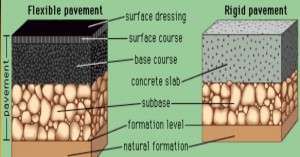Sub Base Course of Rigid Pavement
This is the layer (or layers) under the base layer. The properties and function of this layer are similar to those under flexible roads/pavements. A sub-base is not always needed and therefore may often be omitted.

Base Course of Rigid Pavement
This is the layer directly below the PCC layer and generally consists of aggregate or stabilized sub-grade.
- It provides additional load distribution, contributes to drainage, uniform support to the pavement and a stable platform for construction equipment.
- Bases also help prevent sub grade soil movement due to slab pumping.
Base courses are usually constructed out of
- Aggregate base.
- Stabilized aggregate or soil.
- Dense-graded Hot Mix Asphalt.
- Lean concrete.
Leave a Reply